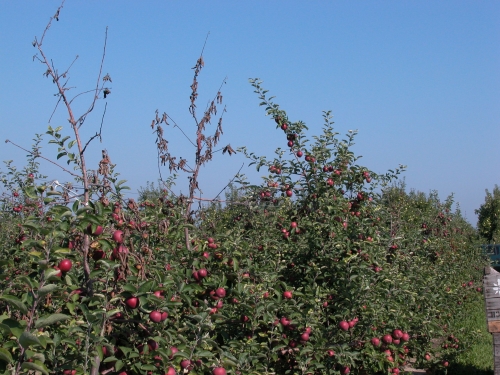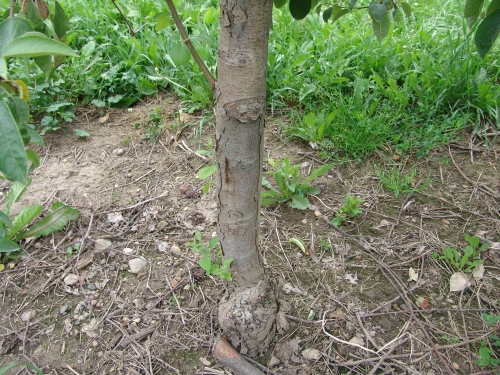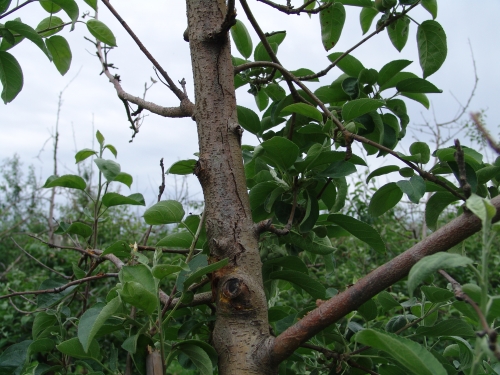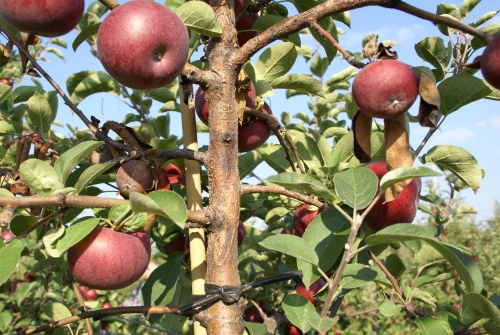Dieback issues in McIntosh cultivars in Michigan
Editor’s note: This article is from the archives of the MSU Crop Advisory Team Alerts. Check the label of any pesticide referenced to ensure your use is included.
Several orchards of McIntosh apple cultivars have been reporting severe branch dieback. The similarities among the affected trees are that the cultivars are primarily Linda Mac and Pioneer Mac with the trees grown on dwarfing rootstocks. The Tree Fruit Pathology lab at Michigan State University has been collecting samples throughout Michigan as growers report symptoms. This article is a summary of knowledge thus far relating to this situation.
Initial dieback symptoms began to be reported to us in 2008 on Linda Mac apples in isolated blocks. From these first samples, the fungal organism that causes anthracnose disease, Cryptosporiopsis curvispora, was identified. By 2010, more blocks throughout Michigan were reporting dieback symptoms, and we have obtained samples from many of those. When samples are collected, information such as planting year, rootstock, cultivar, site details and nursery source was gathered as well. At this time, there appears to be no common nursery source for affected trees. All are on various dwarf rootstock plantings with no correlation either to one particular rootstock.
The focus of the tree fruit pathology lab has been on identification of a causal organism so we can best fit management recommendations to the disease. Currently, several fungal organisms have been isolated from various samples of dying branches. Thus, there are likely multiple pathogens involved in causing this dieback problem statewide. Most of these fungi are opportunistic organisms, and we have isolated the causal agent of black rot (Botryosphaeria obtusa), white rot or bot rot (Botryosphaeria dothidea), anthracnose (Cryptosporiopsis curvispora or C. perennans), as well as Leucostoma (Cytospora), Alternaria, and Nectria cinnabarina. To summarize, currently five different fungi have been isolated in association with this disease problem in addition to the anthracnose pathogen C. curvispora.
While any one of these fungi could be causing the initial infection, it is very difficult to determine if only one is causing dieback, when all are commonly isolated. These fungi typically move into already damaged tissue to cause further rot, but alone, most of these fungi do not usually cause stem cankers. It should also be noted that once isolated cultures are identified, they will all have to be inoculated into similar apple systems to determine if the same symptoms of dieback are found.
Here are some thoughts on why we are observing this disease in McIntosh now when this cultivar has been a staple of the Michigan apple industry for many years. The first observation is that symptoms are expressed on newer cultivars of McIntosh – cultivars that have had very little field testing prior to release by nurseries. Our current apple marketing system demands new and improved varieties all the time. New cultivars go from discovery to nursery propagation very quickly. In this accelerated system, growers assume all the risk when planting new apple cultivars with little or no research on possible novel cultivar-specific problems being done prior to field planting.
Our data regarding the involvement of multiple fungal opportunistic pathogens in this disease also suggests that horticultural issues associated with these newer cultivars are in play. Perhaps newer plantings of these McIntosh cultivars on dwarf rootstocks are not hardening off well and some early winter cold weather is causing damage to tissues thus enabling infection by these opportunistic fungi. Thirdly, there has also been much talk lately of the effects of glyphosate herbicide use on apple tissues. Most interesting is that glyphosate injures apple bark tissue, not enough to kill the tree, but just enough to allow an opportunity for fungi to infect wounded areas. Thus, herbicide issues may also be in play in terms of providing access to fungal pathogens.
For now, what can apple producers do if they observe dieback symptoms in their macs? Regardless of the actual pathogen, management of these opportunistic fungi is basically similar. At this time, no known fungicides can prevent or eradicate these fungi. It has been suggested that copper applications at leaf drop will slow infections at leaf abscission areas, but this has not been proven scientifically. Aggressively pruning out infected branches is critical. Balancing nutrition is important too.
Continued testing will be conducted by the Sundin lab at MSU. Contact your county fruit educator if you are seeing this kind of injury or for more details on sampling. This topic will be covered in the apple education sessions of the 2010 Great Lakes Fruit, Vegetable and Farm Market Expo.
Photos 1-4. Examples of dieback and cankers on Linda Mac trees.




Dr. Sundin's work is funded in part by MSU's AgBioResearch.



 Print
Print Email
Email




